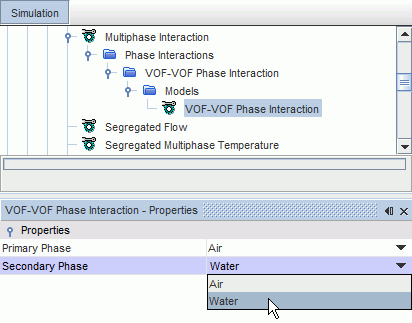Controlling Phase Interactions in VOF Simulations
You create and define the appropriate VOF phase interactions.
The procedure for creating a phase interaction is described in Creating a Phase Interaction.
The following phase interaction models are available in VOF simulations:
- VOF-VOF Phase Interaction model, which controls the interaction between two VOF phases.
- Film-VOF Phase Interaction
model, which controls the interaction between the fluid film phase
and a VOF phase.
This model is available only when the Fluid Film model is activated in the physics continuum.
- VOF-Lagrangian Phase Interaction model, which controls the
interaction between a VOF phase and a Lagrangian phase.
This model is available only when the Lagrangian Multiphase model is activated in the physics continuum.
A phase interaction model becomes available when both of the relevant phases exist.
| Phase Combination Modeled | Physical Phenomena Modeled |
|---|---|
| Gas-Liquid |
Evaporation Condensation Boiling Cavitation Gas Dissolution |
| Liquid-Solid |
Melting Solidification |
The primary and secondary phases are specified when you create the phase interaction, but you can change them if necessary. These settings affect the optional models that are made available.
To change the primary and secondary phases:
-
Select the node and set the appropriate phases:

Define the phase interaction.
-
Reopen the
Phase Interaction Model Selection dialog and select the appropriate optional models for the phase interaction.
Mass Transfer Models:
Model Relevant information Evaporation/Condensation Boiling Two models are available: Rohsenow Boiling and Transition Boiling
See Modeling Boiling.
Cavitation Three models are available: Full Rayleigh-Plesset, Homogeneous Relaxation, and Schnerr-Sauer.
See Modeling Cavitation.
Gas Dissolution Melting and Solidification Interphase Reaction Interphase reactions are modeled with the Interphase Reaction model. Both of the phases must be multi-component.
Other models:
Model Relevant information Slip Velocity See Slip Velocity Model.
The Slip Velocity model can be unstable in some situations, especially for a large interaction length scale. Two ways that you can resolve the problem are outlined below. These methods are applicable only to Drag-based slip.
-
Set the Phase Slip Velocity solver Under-Relaxation Factor.
Smaller under-relaxation values provide more stability, but also give slower convergence.
-
Set the Phase Slip Velocity solver Body Force Smoothing Iterations.
Higher values provide a more uniform distribution of specific body forces and therefore more stability, but also decrease the local resolution of body forces.
Contact Time Interaction Area Density Interaction Length Scale See Interaction Length Scale Model Reference. Interface Turbulence Damping This model is useful in simulations that contain a liquid-gas interface with a high relative velocity between the phases. For example, the flow of water on the windows of a moving vehicle: the water flow is slow and dominated by surface tension, but the air flow velocity can be high and aerodynamic forces are significant.
The K-Omega Turbulence, K-Epsilon Turbulence or Reynolds Stress Turbulence model must be activated in the physics continuum.
Set the appropriate damping coefficient method and value.
Interface Momentum Dissipation VOF Phase Replacement See Replacing VOF Phases.
Surface Tension Force Macro Porosity (fully coupled) and Macro Porosity (pure thermal) -
-
Select the node and set Method to one of the following options:
- Gradient Corrected Standard
- Standard
- User Specified
-
Define a VOF-Lagrangian phase interaction.
- Right-click the node and click Select Models.
- In the model selection dialog, activate the following models in order:
Group Box
Model
Optional Models
- Resolved Transition—identifies large
blobs
that move through the VOF field with significant
momentum and velocity (also known as ballistic
blobs) and transitions them into computationally
more efficient LMP particles.
See Resolved Transition.
-
VOF-Lagrangian User Stripping—models the Lagrangian particles stripping from a VOF surface. The VOF-Lagrangian User Stripping model allows you to select the diameter of the injected particles and the mass flux injected.
-
Impingement—models the impingement of a Lagrangian phase on to an VOF Eulerian phase.
See Modeling Impingement.